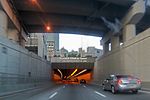Echo of the Waves
1980s establishments in Massachusetts1980s sculpturesAbstract sculptures in the United StatesDolphins in artFiberglass sculptures in the United States ... and 5 more
Kinetic sculptures in the United StatesMassachusetts sculpture stubsOutdoor sculptures in BostonSteel sculptures in MassachusettsWhales in art
Echo of the Waves (also known as Dolphin or Whale) is a sculpture by Susumu Shingu, installed outside the New England Aquarium, in Boston, Massachusetts, United States. It was completed in September 1981, and dedicated on July 6, 1983. The abstract, kinetic structure is made of painted steel and Teflon coated fiberglass, and rests on a painted steel base. It was surveyed as part of the Smithsonian Institution's "Save Outdoor Sculpture!" program in 1994.
Excerpt from the Wikipedia article Echo of the Waves (License: CC BY-SA 3.0, Authors).Echo of the Waves
Boston HarborWalk, Boston North End
Geographical coordinates (GPS) Address Nearby Places Show on map
Geographical coordinates (GPS)
| Latitude | Longitude |
|---|---|
| N 42.359051 ° | E -71.050733 ° |
Address
Central Wharf (New England Aquarium)
Boston HarborWalk
02109 Boston, North End
Massachusetts, United States
Open on Google Maps










